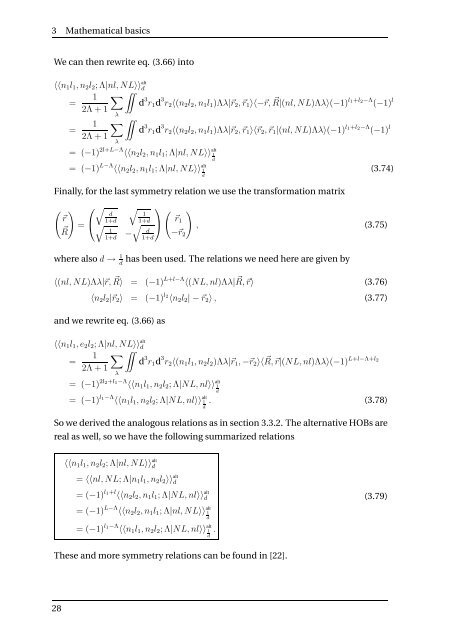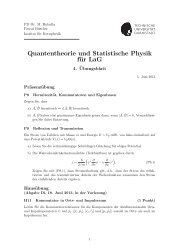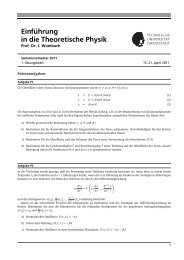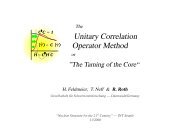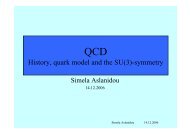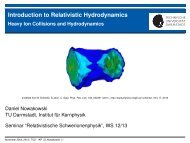Consistent chiral three-nucleon interactions in ... - Theory Center
Consistent chiral three-nucleon interactions in ... - Theory Center
Consistent chiral three-nucleon interactions in ... - Theory Center
You also want an ePaper? Increase the reach of your titles
YUMPU automatically turns print PDFs into web optimized ePapers that Google loves.
3 Mathematical basics<br />
We can then rewrite eq. (3.66) <strong>in</strong>to<br />
〈〈n1l1, n2l2; Λ|nl, NL〉〉 alt<br />
d<br />
1 <br />
¨<br />
=<br />
2Λ + 1<br />
λ<br />
1 <br />
¨<br />
=<br />
2Λ + 1<br />
d 3 r1d 3 r2〈(n2l2, n1l1)Λλ|r2,r1〉〈−r, R|(nl, NL)Λλ〉(−1) l1+l2−Λ (−1) l<br />
d 3 r1d 3 r2〈(n2l2, n1l1)Λλ|r2,r1〉〈r2,r1|(nl, NL)Λλ〉(−1) l1+l2−Λ (−1) l<br />
λ<br />
= (−1) 2l+L−Λ 〈〈n2l2, n1l1; Λ|nl, NL〉〉 alt<br />
1<br />
d<br />
= (−1) L−Λ 〈〈n2l2, n1l1; Λ|nl, NL〉〉 alt<br />
1<br />
d<br />
F<strong>in</strong>ally, for the last symmetry relation we use the transformation matrix<br />
d<br />
⎛<br />
r<br />
R<br />
1+d<br />
= ⎝<br />
1<br />
1+d −<br />
<br />
1<br />
1+d <br />
d<br />
1+d<br />
(3.74)<br />
⎞ <br />
⎠<br />
r1<br />
−r2<br />
, (3.75)<br />
where also d → 1 has been used. The relations we need here are given by<br />
d<br />
〈(nl, NL)Λλ|r, R〉 = (−1) L+l−Λ 〈(NL, nl)Λλ| R,r〉 (3.76)<br />
〈n2l2|r2〉 = (−1) l2 〈n2l2| − r2〉 , (3.77)<br />
and we rewrite eq. (3.66) as<br />
〈〈n1l1, e2l2; Λ|nl, NL〉〉 alt<br />
d<br />
1 <br />
¨<br />
=<br />
2Λ + 1<br />
d 3 r1d 3 r2〈(n1l1, n2l2)Λλ|r1, −r2〉〈 R,r|(NL, nl)Λλ〉(−1) L+l−Λ+l2<br />
λ<br />
= (−1) 2l2+l1−Λ<br />
〈〈n1l1, n2l2; Λ|NL, nl〉〉 alt<br />
1<br />
d<br />
= (−1) l1−Λ<br />
〈〈n1l1, n2l2; Λ|NL, nl〉〉 alt<br />
1<br />
d<br />
. (3.78)<br />
So we derived the analogous relations as <strong>in</strong> section 3.3.2. The alternative HOBs are<br />
real as well, so we have the follow<strong>in</strong>g summarized relations<br />
〈〈n1l1, n2l2; Λ|nl, NL〉〉 alt<br />
d<br />
= 〈〈nl, NL; Λ|n1l1, n2l2〉〉 alt<br />
d<br />
= (−1) l1+l 〈〈n2l2, n1l1; Λ|NL, nl〉〉 alt<br />
d<br />
= (−1) L−Λ 〈〈n2l2, n1l1; Λ|nl, NL〉〉 alt<br />
1<br />
d<br />
= (−1) l1−Λ<br />
〈〈n1l1, n2l2; Λ|NL, nl〉〉 alt<br />
1 .<br />
d<br />
These and more symmetry relations can be found <strong>in</strong> [22].<br />
28<br />
(3.79)


